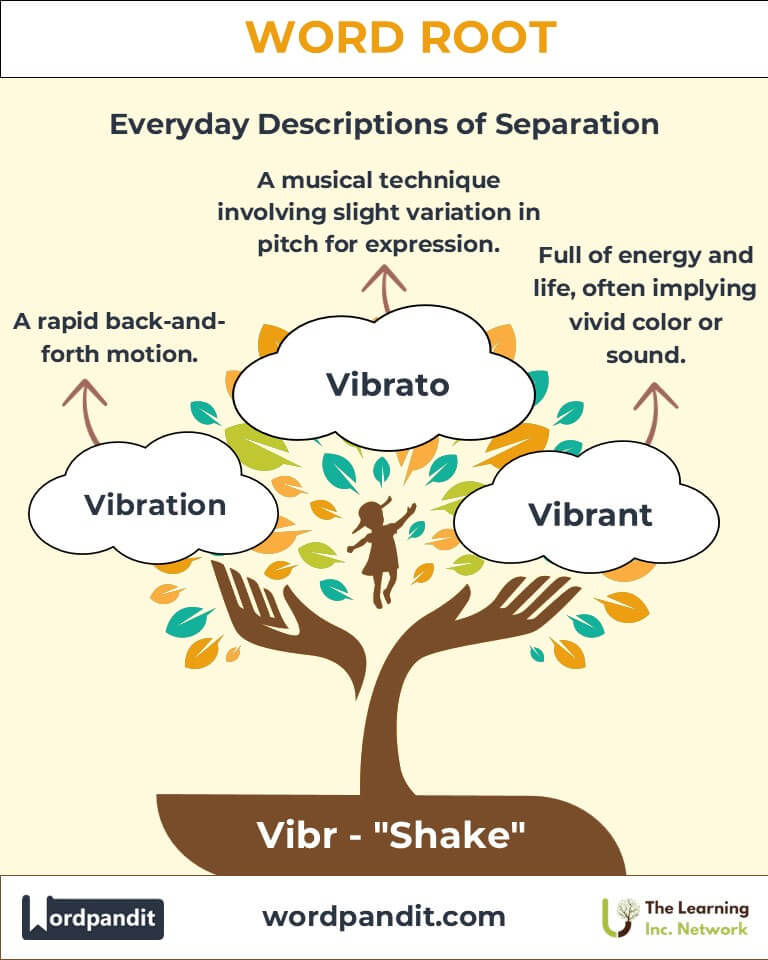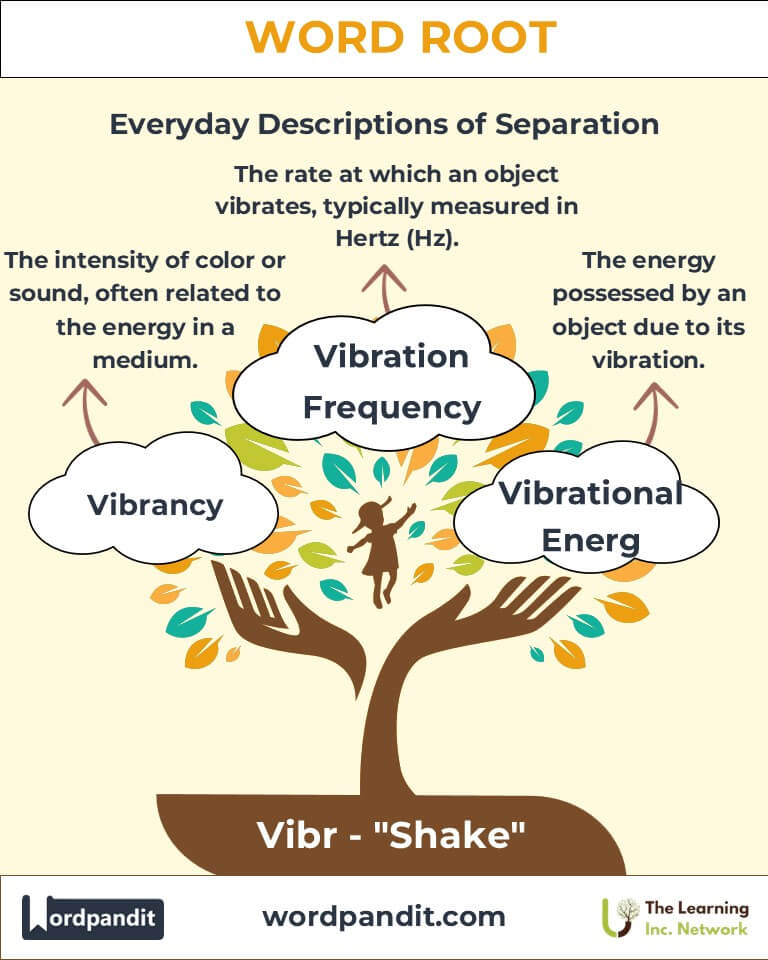Vibr: The Root of Motion and Resonance
Discover the dynamic essence of the word root "vibr," derived from Latin, meaning "shake." This root animates words across language, describing motion, energy, and resonance in various contexts, from music to technology. Whether it's the vibrations of a guitar string or the energy of a vibrating smartphone, "vibr" symbolizes a world in motion.

Table of Contents
- Introduction: The Essence of "Vibr"
- Etymology and Historical Journey
- Mnemonic: Unlocking the Power of Vibr
- Common Vibr-Related Terms
- Vibr Through Time
- Vibr in Specialized Fields
- Illustrative Story: Vibr in Action
- Cultural Significance of the Vibr Root
- The Vibr Family Tree
- FAQs about the Vibr Word Root
- Test Your Knowledge: Vibr Word Root Quiz
- Conclusion: The Living Legacy of Vibr
1. Introduction: The Essence of "Vibr"
What makes sound waves travel or a phone alert you with a buzz? It's all thanks to the root "vibr", meaning "shake." Derived from the Latin vibrare, this root infuses words with a sense of energy and motion. Pronounced as "vy-br," it resonates in everyday language and specialized terminologies alike, reflecting movement and rhythm in various domains.

2. Etymology and Historical Journey
The root "vibr" originates from the Latin vibrare, meaning "to shake or quiver." In ancient times, this term described physical motion, like the quivering of a bowstring. Over centuries, it evolved to represent both literal and metaphorical movement, appearing in early English texts to describe oscillation, tremors, and energetic activity.
3. Mnemonic: Unlocking the Power of Vibr
Imagine a tuning fork vibrating after being struck, its oscillations sending ripples through the air. This imagery captures the essence of "vibr."
Mnemonic Device: "Vibr is the motion in vibration, quivering through every sensation."
4. Common Vibr-Related Terms
- Vibrate (vahy-brayt):
- Definition: To move back and forth or to and fro.
- Example: "The phone began to vibrate, signaling an incoming call."
- Vibration (vahy-bray-shun):
- Definition: The act or state of vibrating; oscillatory motion.
- Example: "The vibrations of the guitar strings produced a beautiful melody."
- Vibrant (vahy-bruhnt):
- Definition: Full of energy, life, or color.
- Example: "The vibrant colors of the painting brought the room to life."
- Vibrator (vahy-bray-ter):
- Definition: A device or tool that produces vibrations.
- Example: "The massager uses a small vibrator to relieve muscle tension."
- Vibrancy (vahy-bruhn-see):
- Definition: The quality of being full of energy and enthusiasm.
- Example: "The vibrancy of the city nightlife is unmatched."
5. Vibr Through Time
- Oscillation: An early representation of vibration in physics, focusing on periodic movement.
Example: Galileo’s study of pendulums brought vibrational motion into scientific discourse. - Resonance: Evolved to describe sound waves and mechanical vibrations in the 17th century.
Example: The term now applies to both physical and metaphorical harmony.
6. Vibr in Specialized Fields
- Music:
- Term: Vibrato
- Definition: A slight fluctuation in pitch used by musicians to enhance sound.
- Example: "Her violin vibrato added emotional depth to the performance."
- Physics:
- Term: Vibrational Energy
- Definition: Energy associated with the oscillatory motion of particles.
- Example: "Vibrational energy plays a key role in molecular spectroscopy."
- Technology:
- Term: Vibration Sensors
- Definition: Devices that detect oscillations or disturbances in a system.
- Example: "Vibration sensors are critical for monitoring machinery health."
- Medicine:
- Term: Vibratory Therapy
- Definition: A treatment that uses vibrations to stimulate circulation and healing.
- Example: "Vibratory therapy aids in muscle recovery after intense exercise."
7. Illustrative Story: Vibr in Action
Maria, a young musician, struggled to perfect her violin technique. Her teacher encouraged her to master vibrato, the art of vibrating the string to enrich the tone. Through relentless practice, Maria discovered how subtle vibrations could transform simple notes into soulful expressions. Her newfound skill inspired her to explore the science of resonance, deepening her appreciation for the interplay of sound and motion.
8. Cultural Significance of the Vibr Root
The root "vibr" is deeply ingrained in human culture, symbolizing energy and life. From the vibrant rhythms of African drums to the vibrational therapy used in modern medicine, "vibr" represents connection, harmony, and vitality. It underscores the importance of movement, not just in the physical sense but also in emotional and cultural expressions.

9. The Vibr Family Tree
- Oscill (Latin: "to swing"):
- Example: Oscillate: To move back and forth at a regular speed.
- Reson (Latin: "to resound"):
- Example: Resonance: The reinforcement of sound by reflection or synchronization.
- Trem (Latin: "to tremble"):
- Example: Tremor: An involuntary shaking movement.

10. FAQs About " Vibr "
Q: What does "vibr" mean?
A: "Vibr" is derived from the Latin root "vibrare," meaning "to shake" or "to quiver." It symbolizes movement, oscillation, or energy. This root is foundational in words describing physical shaking, energetic resonance, or metaphorical liveliness.
Q: What is vibrational energy?
A: Vibrational energy refers to the energy associated with the oscillatory motion of particles in an object or system. In physics, it is a form of kinetic energy, as seen in vibrating molecules. This principle is widely applied in molecular spectroscopy, sound engineering, and even quantum mechanics.
Q: How does vibration differ from oscillation?
A: While both involve motion, vibration generally refers to rapid, repetitive movements over a small range, such as the trembling of a phone. Oscillation, on the other hand, involves larger, slower, and often regular movements, like the swing of a pendulum.
Q: Why is vibration important in music?
A: Vibrations are the foundation of sound production in music. For example, vibrating strings on a guitar or vocal cords in a singer create waves that propagate through the air, generating audible sound. Vibrato, a musical technique, uses controlled vibrations to enhance the expressiveness of a note.
Q: What is vibrational therapy, and how is it used?
A: Vibrational therapy involves applying specific frequencies or oscillations to stimulate healing or relaxation. It's used in physical rehabilitation to enhance circulation, reduce muscle tension, and accelerate tissue repair, demonstrating the practical applications of the "vibr" root.
Q: What does "vibrant" mean in a figurative sense?
A: In a figurative context, "vibrant" refers to something full of life, energy, or intensity. It can describe lively colors, dynamic personalities, or bustling environments, all of which evoke a sense of motion or energy.
Q: What are vibration sensors, and where are they used?
A: Vibration sensors detect oscillations in systems or environments. They are widely used in engineering to monitor machinery health, in seismology to detect earthquakes, and in consumer electronics, such as smartphones, for user notifications.
11. Test Your Knowledge: " Vibr " Mastery Quiz
1. What does the root "vibr" signify?
2. Which term describes a fluctuation in musical pitch?
3. What is vibrational energy?
4. What does "vibrant" mean in the context of personality?
5. Which field commonly uses vibration sensors?
12. Conclusion: The Living Legacy of Vibr
The root "vibr" animates our understanding of motion, resonance, and energy. From the vibrant beats of music to the subtle oscillations in nature and technology, it connects us to a dynamic world. Embracing "vibr" not only enriches our vocabulary but also deepens our appreciation for the ever-present motion that surrounds us.












